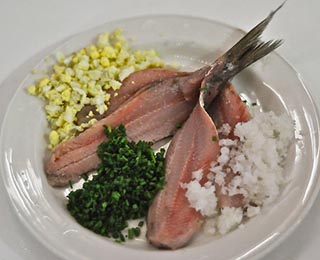Buying
Herring fish is highly perishable if not processed early and stored adequately. Just like other pelagic fish, fresh herrings are often sold by coastal fishermen who sell them soon after catching them from the ocean.
At home, store them in the freezer section for extended use.
Herring is one of the most plentiful and harvested saltwater fish in the world. It sold fresh and frozen, whole or fillets but also canned, marinated, salt-cured, and smoked.
Cured herring is sold in cans. Bloater is usually a whole herring, un-gutted, barely salted, semi-smoked. It keeps for 5 days. Buckling is lightly brined, hot-smoked, and thus partly cooked, which can be eaten without further cooking. It is especially popular in Germany and Holland. Buckling keeps for 4 days.
Kipper is a large herring with its head removed, split into along the back, boned, flattened, and barely smoked (cold). Kippers can be eaten as is or they can be cooked for a few minutes. They sold fresh in cans, frozen, or in ready-to-cook sachets. They keep for 5 days.
Pickled herring fish
Pickled herrings are a popular, traditional accompaniment in German, Dutch, and other Scandinavian cuisines. Salt-cured herrings are typically preserved in vinegar and spices like peppercorn, , , etc.
Preparation
Herring fish contains small bones, which are best removed before cooking. Prepare them just like other small, round fish. Remove the fins and trim the tail. To scale the herring, simply wipe it.
To gut the fish, lay it on a board with the skin side up. Turn the fish over. Cut off the head, almost through the spine, and twist, gently pull the innards away from the head. Press down along the backbone and gently pull the backbone away from the flesh. Pick out any left-over small bones.
Wash in cold water and pat dry with kitchen paper.
Here are some serving ideas:
Herring can replace mackerel in many recipes. It is very often marinated, smoked, and canned.
-
Herrings are best grilled or baked or pan-fried whole. They are not suited for poaching. Avoid overcooking.
-
In traditional Scottish recipe, herring fish are rolled in coarse oatmeal and fried in bacon fat.
-
Herrings are most popular in their various smoked and cured forms.
Safety profile
Being a small, coastal pelagic oily fish, herrings contain traces of heavy metals and dioxins (Polychlorinated dibenzodioxins (PCDDs)). However, this toxin is too small unlike other large fish like tuna, and therefore considered safe to eat up to 12 ounces (2 average meals) a week.
Avoid if your herrings are from known polluted pelagic waters where the risks of exposure to these compounds are high due to environmental pollution. Pay attention to local advisories. If advice isn’t available, limit its consumption to 6 ounces (170 grams) a week.
The mean mercury concentration in herring fish is 0.078 ppm. Accordingly, the U.S. FDA final guidelines on how much fish expectant as well as breastfeeding mothers can eat, along with lists of specific options that are safe or should be avoided, place Hake in the “best choice” category. By this yardstick, they can consume 2-3 servings (8-1 ounces) of herrings per week.
Pickled herring is rich in tyramine and thus, should be avoided in the diet of people on antidepressant medication with monoamine oxidase (MAO) inhibitors.
().
Also read ≻≻-
≻≻- nutrition facts and health benefits.
≻≻- nutrition facts and health benefits.
≻≻- nutrition facts and health benefits.
≻≻-Back to
Further reading (Links opens in new window):
-
.
-
.
-
.
-
Omega-3 Fatty Acids: .
